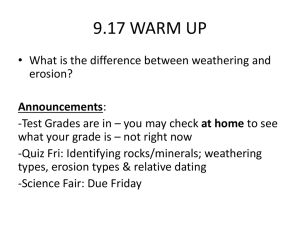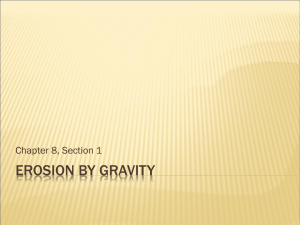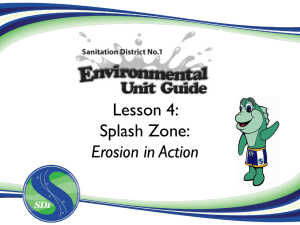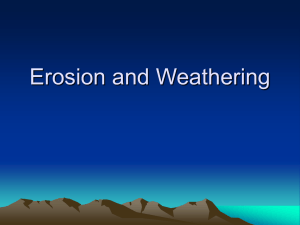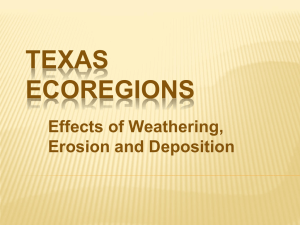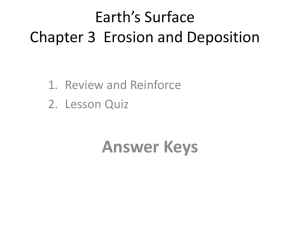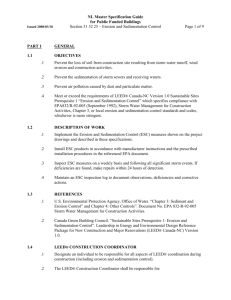File - Ms. D. Science CGPA
advertisement
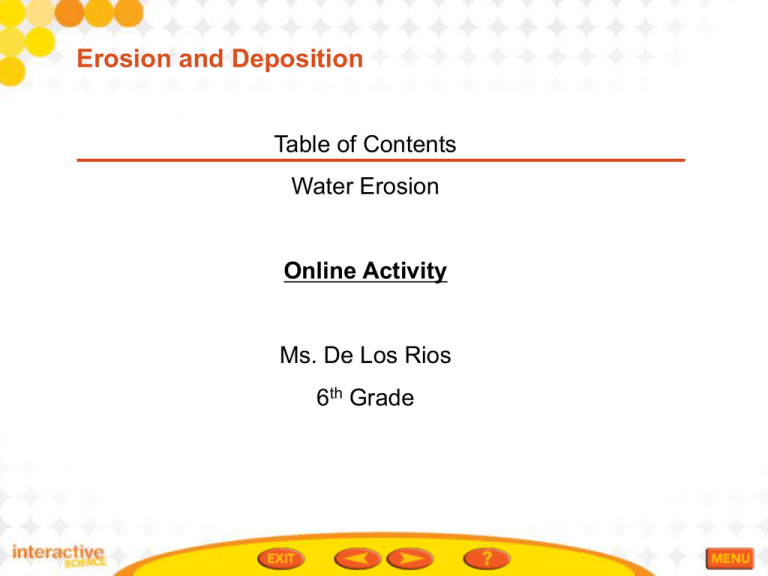
Erosion and Deposition Table of Contents Water Erosion Online Activity Ms. De Los Rios 6th Grade Vocabulary Ch. 4.1 1. Runoff- Water that flows over the ground surface rather than soaking into the ground. 2. Rills- A tiny groove in soil made by flowing water. 3. Gully- A large channel in soil that carries runoff after a rainstorm. 4. Stream- A channel through which water is continually flowing downhill. 5. Tributary- A stream or river that flows into a larger river. 6. Flood plain- a flat valley through which a river flows through. ‘ 7. Meander- A looplike bend in the course of a river. 8. oxbow lake- A meander cut off from a river. Vocabulary 4.1 9. Delta- A landform made of sediment that is deposited where a river flows into an ocean or lake. 9. Alluvial fan- a wide, sloping deposit of sediment formed where a stream leaves a mountain range. 10. Groundwater- Water that fills the cracks and spaces in underground soil and rock layers. 11. Stalactite- An icicle-like structure that hangs from the ceiling of a cavern. 12. Stalagmite- a column-like form that grows upward from the floor of a cavern. Karst Topography- Karst Topography (K.T.) landscape in rainy regions where there is limestone near the surface and has caverns, sinkholes, and deep valleys. (sinkholes are more likely found in regions with K.T.) Pg. 114-115 What process do you know that breaks up rocks? Weathering What are the agents or natural forces that weather rocks? Water, living things, oxygen, carbon dioxide, changing temperature What forces on Earth have you observed picking up or moving rocks, sand, or mud? Floodwaters, gravity, strong winds, and people Pg. 116 Mass- is an amount of matter that has and indefinite size and shape. Force- is the push or pull exerted on an object. Cycle- is a sequence of events that repeats over and over again. Give samples of various types of cycles • • • Water Agent(force that causes change) of Erosion •How can water be an agent of erosion? By flowing over Earth’s surface. •In what ways does this water flow? As a sheet, in rills, in gullies, and in streams. •What factors determine the amount of runoff in an area? Amount of rain, vegetation, type of soil, shape of the land, how the land is used. Factors and Processes that Shape Earth’s Surface •How do people shape Earth’s surface? They dig sediment and rocks from one place and dump them at another place. Water also picks up sediment at one place and deposits it at another. Which factor/process do you think moves more sediment, people or water? Water moves much more sediment than people. How Does Moving Water Causes Erosion? Moving water is the major agent of the erosion that has shaped Earth’s land surface. • As water moves over the land, it carries particles with it. This moving water is called runoff. The amount of runoff in an area depends on five main factors: 1. the amount of rain an area gets, 2. the area’s vegetation 3. the type of soil 4. the shape of the land 5. how people use the land Water Erosion pg. 119 Factors Affecting Runoff 1. What are the five main factors affecting runoff, and what are some examples? 2. Using a specific location, such as a local park, identify an example for each factor. 3. Explain to a partner what the runoff would be like at your location. Stream Formation pg. 120 As runoff travels downhill under gravity, it forms tiny grooves in the soil called rills. When many rills flow into one another, they grow large, forming a gully. A gully is a large groove, or channel in the soil that carries runoff after a rainstorm. Gullies join together to form a larger channel called a stream. A stream is a channel along which water is continually flowing down a slope. A large stream is often called a river. A stream or river that flows into a larger river called a tributary. As water moves across the land it forms: pg. 120 Rills Gullies Streams River Tributary Key Concepts How can water move soil and sediment? By flowing over Earth’s surface In what ways does the water flow? Sheet, in rills, gullies, and in streams. Water Erosion pg. 120 Stream Formation Which arrows indicate the direction of sheet erosion? Where are rills and gullies in the picture? Streams and rivers? Tributaries? Land Features formed by Water Erosion pg. 122 As water moves it forms through erosion: 1. 2. 3. 4. 5. V__________ W__________ F_______ P_________ M__________ O_______ L_________ What Land Features Are Formed by Water Erosion? Pg. 122 Through erosion, a river creates valleys, waterfalls, flood plains, meanders, and oxbow lakes. • The flat, wide area of land along a river is a flood plain. • A meander is a looplike bend in the course of a river. • An oxbow lake is a meander that has been cut off from the river. • Waterfalls form where a river meets an area of rock that is very hard and erodes slowly. Water Erosion Waterfalls Where do you think the layers of hard and soft rock are located? Water Erosion Fig. 5 pg. 123 Oxbow Lakes What happens in step 4 of this diagram to form an oxbow lake? Land Features formed by Water Deposition pg. 124 As water moves it carries sediment and deposits it forming: 1. 2. What Land Features Are Formed by Deposition? Pg. 124 Deposition creates landforms such as alluvial fans and deltas. Sediment deposited where a river flows into an ocean or lake builds up a landform called a delta. An alluvial fan is a wide, sloping deposit of sediment formed where a stream leaves a mountain range. It is shaped like a fan. Water Erosion pg. 124 Water Deposition Deposition creates landforms such as the Mississippi River delta. Water Erosion Fig. 7 pg. 125 Rolling Through the Hills Identify the two missing features on the image. Groundwater Erosion pg. 126 Groundwater is the term geologists use for underground water. . Groundwater can cause erosion via chemical weathering. • Rain water is acidic • Atmosphere = water+ carbon dioxide= carbonic acidic (weak acid) • Carbonic acid breaks down limestone- the limestone is carried away in the water. Gradually, little by little, this process hollows out the rock forming caves/caverns. Cave Formations pg. 126 Did you know that Carbonic acid on limestone can also result in deposition!! • A deposit that hangs like an icicle from the roof of a cave is known as a stalactite. Slow dripping builds up a cone-shaped stalagmite floor. from the cave Karst topography is a type of landscape in rainy regions where there is limestone near the surface and characterized by caverns, sinkholes, and deep valleys. The Schellenberg ice cave pg, 126 The Schellenberg ice cave in Germany is a limestone cave with ice formations. Cold air is trapped in the lower areas of the cave so the temperature stays near freezing. This keeps the ice formations from melting. Water Erosion Fig. 6 pg. 126 Groundwater Erosion and Deposition How do the processes of Erosion and Deposition form caves? Water Erosion Apply it! Pg. 127 Karst Topography Why do you think karst topography occurs in these areas? 1. Name three states in which you can find Karst topography? ____________________ ____________________ ____________________ 2. Why do you think Karst topography occurs in these areas? ____________________ ____________________ ____________________


